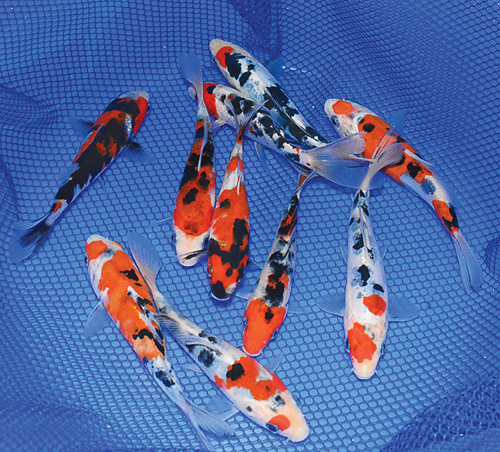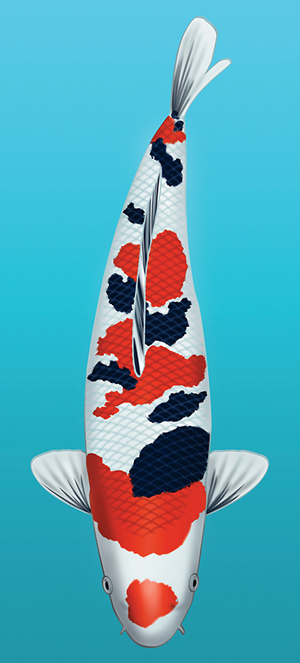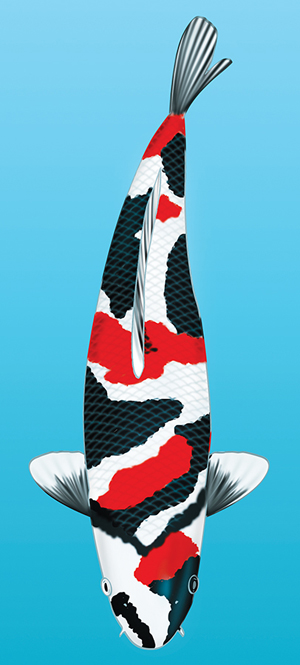
Many hobbyists love Sanke and Showa koi — the tri-colored koi that are white, red and black — yet they often struggle to distinguish one variety from the other. I am often asked, “Are they white fish with red and black markings, or black fish with red and white markings? How do I tell the difference between Sanke and Showa koi?” Also overheard: “What is the rule for black on the koi’s head? Do all Sanke have white fins?”
There are many similarities between Sanke and Showa koi. Aside from the fact that both share three colors, both are also non-metallic members of the Gosanke group, produced with Doitsu and Ginrin scale variations. To muddy the waters even more, Sanke and Showa koi can look very much alike at a young age and can take several years to fully finish. So it’s no wonder that most people have a difficult time telling them apart, especially at first glance.
You may even have some of these three-colored koi in your retail tanks and yearn to easily determine which are Sanke, and which are Showa. With so much in common, making the distinction between the two varieties can be quite a challenge. This article will provide five tips to distinguish Sanke from Showa koi and make it easier to correctly identify each variety, thus boosting your confidence when it comes to koi knowledge and giving your customers the sound advice they are looking for.
>> Related Content | Five Easy Ways to Identify Your Koi
1. Use the Color Rule to Identify Sanke and Showa Koi

The number of different colors is the first clue to naming the variety correctly. Both Sanke and Showa have three colors — white, red and black. Each color should be vivid and clearly defined on the fish, with an obvious distinction between the colors. Color depth is important, too: it should be a uniform hue, regardless of where it appears on the koi. Each color should appear solid, dense and free of any other color.
Sanke: White and red with black accents
• White, or shiroji (sheer-row-gee), is the base color on Sanke. It begins at the nose and continues to the tail, including the fins. It should be clean, bright and not discolored in any way.
• The red on Sanke is called hi (he) or beni (ben-ny) in Japanese. Beni tends to be more of an orange shade rather than a true, fire engine red. Sanke usually have large, reddish-orange patches that form the foundation of their color pattern, with the white base generally visible between the patches of beni.
• Black, or sumi (sue-me), is the rarest color on Sanke. Generally, Sanke will have black spots, or sumi markings, that are relatively small when compared to the prominent beni patches. Sumi can be thought of as an accent color, while beni and shiroji are the primary colors on Sanke.
Showa: Black with red and white accents
• Showa koi have a thick, sumi-dominant base color with a shiny appearance. The black extends along the length of the body and sparsely extends into the fins. The solid black color is of major importance when identifying Showa.
• Beni often appears on Showa in large patches. A strong and dense concentration of red is preferred, ideally on the face, back and tail section.
• White pigmented areas intertwine with the sumi, breaking up the black background to form interesting patterns.
2. Where’s the Pattern?
Pattern location is also a clue in determining the correct variety. Sanke and Showa have distinctly different kinds of patterns. Determine if the pattern lies primarily on the back of the fish, or if it wraps around the body. Does it appear mostly above the lateral line, or does the pattern reach down the sides to the belly of the koi?
Sanke patterns usually lie on the back of the koi and are confined above the lateral line. However, beni patches may occasionally extend downward, slightly below the lateral line.Showa, on the other hand, have prominent, heavy patterns that wrap around the fish’s body, often extending far beyond the lateral line down to the belly, encompassing the body. When you see a koi with a significant, heavy pattern that encircles the fish, you can bet it’s a Showa.
Here’s an easy way to remember this tip: Showa ends with “-wa,” and its patterns wrap around. As a general rule, if there is a “w” in the variety name, keep an eye out for wrapping colors.
3. Sumi Accents: Small Spots or Wide Bands?
The size and shape of the black pigment are additional clues to use in accurately identifying each koi variety. When trying to decide if you are looking at Sanke or Showa, evaluate the sumi markings.
Small, infrequent or isolated sumi spots are indicative of Sanke. The lone, round black spots will appear randomly on the koi’s back above the lateral line to accent the beni pattern. Individual blotches of sumi are one clue to identifying Sanke.
]=Taisho Sanke is commonly called Sanke. The Sanke is a three-colored, non-metallic koi with a white base with hi patches and accenting sumi markings. The pigments appear only above the lateral line. Sumi stripes may appear in the fins.
Large swathes or wide bands of black color appear on Showa. The substantial black markings are quite noteworthy — even powerful-looking, contrary to the modest sumi spots of Sanke. The sumi on Showa should be evident the entire length of the fish. Sumi bands are often joined together to form interesting shapes, sometimes resembling bolts of lightning. If sumi appears as heavy or connecting bands of color, you can be relatively sure you are looking at a Showa.
4. Look It in the Face

The face, or head of the koi will also offer clues to the correct variety. The most obvious difference between the Sanke and Showa is the presence of sumi on the head.
Generally, Sanke will have only two colors on its head — white and red, with no sumi present. The face should be white, as this is the point where the important beni pattern begins.
In contrast, you should see all three colors, including black, on the heads of Showa. Bold Showa patterns begin on the face. In fact, sumi often starts at the mouth and spreads to the cheeks, possibly even joining with sumi on the pectoral fins.
5. Examine the pectoral fins
Generally, the pectoral fins on Sanke will have the same clean, bright, shiroji color as its base. White is the dominant color of the pectoral fins; however, a few sumi stripes may show up here and there to accentuate the pattern. Sumi appearing on only one pectoral fin is not uncommon and perfectly acceptable on Sanke.
Alternatively, sumi is often seen on the pectoral fins of Showa. This feature is called Motogoro (mow-toe go-row). Some Showa have Motogoro that is a solid block of pigment at the fin joint. Some have sumi that flares outward in streaks instead of a single patch that remains close to the body. This trait blends nicely with a bold Showa pattern. However, Motogoro is not always present on all Showa.
One special note, Kindai Showa (kin-die showa) is a more modern version of Showa. It has predominantly more white areas than a traditional Showa. However, it will still have interlocking bands of sumi and beni, just like most Showa.
As a general rule, these are the five things to look for when identifying Sanke or Showa. However, not every koi will exhibit these characteristics. Age, water quality and lineage play significant roles in the development of each of the mentioned traits.
The Showa, or Showa Sanshoku, is also a three-colored, non-metallic koi, but has a predominantly black body with areas of red and white markings that extend below the lateral line. Showa may have sumi at the base of fins and on the head or face. Their colors appear in bands rather than spots.



Sometimes kage showa will be confused as sanke because it’s sume is underneath it’s skin.
Great article. Very interesting, we learned a lot from it. Would a white koi with one red spot on left eye and numerous black spots be a sanke or a tancho sanke?
From Ellen Kloubec:
It is sometimes hard to be 100% accurate without a photo , however, If the red is only on the head of the koi, nowhere else on the fish, it could be classified as a Tancho Sanke.
I have a 3 year old Tancho. Until this past summer it was almost perfect, white with the vivid almost symmetrical red making on the head. It has now developed a minute black marking on the “shoulders”. The fish was a not an insignificant amount of money to buy. Has the emergence of the black marking affected the value?
At last someone gives basic simple advice to us novices…… thank you
It sounds like your Koi has developed a shimi (a tiny spot of black pigment). the value…? Most likely the presence of a shimi will decrease the Koi’s value.